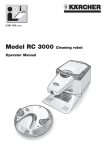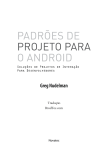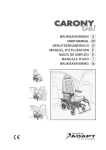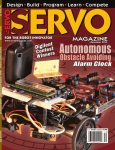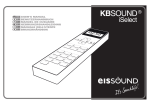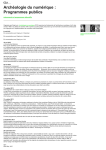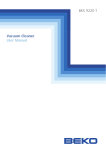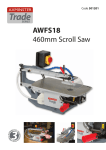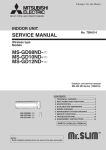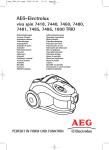Download Kärcher RC3000 RoboCleaner
Transcript
Contents Function and Mode of Operation ............ 18 For Your Safety .......................................... 19 Quick Reference ........................................ 20 Operating Controls ................................... 21 Preparation ................................................ 22 Unpacking ................................................ 22 Installation Notes for the Station .............. 22 Operation ................................................... 23 Preparation for the Cleaning .................... 23 Initial Operation ........................................ 23 Turning the Robot Off ............................... 23 Parking ...................................................... 24 Selecting the Cleaning Duration ............... 24 Quiet mode ............................................... 24 Operating Programs ................................. 24 Tips and Tricks .......................................... 25 Maintenance and Care ............................. 26 Station ...................................................... 26 Robot ........................................................ 26 Troubleshooting ........................................ 28 Specifications ............................................ 29 Warranty ..................................................... 29 EC Declaration of Conformity .................. 29 Frequently Asked Questions .................... 30 Spare Parts List ....................................... 326 Function and Mode of Operation Dear Customer, thank you very much for purchasing the Kärcher cleaning robot RC 3000. The RC 3000 is an automatic cleaning robot for the indoor area of private households. It can be used on all common floor coverings for the autonomous, continuous routine cleaning. The appliance consists of two components - a dokking station and a mobile robot. The robot is operated with rechargeable batteries. It moves according to the random method. If the robot bumps into an obstacle, it changes its direction at a random angle. Then, it goes straight ahead until it bumps into the next obstacle. The flat design of the robot allows it to also clean the floor underneath pieces of furniture, such as beds, sofas, cupboards, and wardrobes. The robot is working with optical sensors that detect stairs and steps and prevent the robot from falling down. The robot provides of four operating programs that allow him to automatically adjust to the various degrees of dirt accumulation on the floor. The control of the operating programs is performed by means of sensors located in the dirt receptacle and depends on the detected degree of dirt accumulation. If the battery is charged completely, the robot can clean up to 60 minutes. After 20 minutes at the earliest, the robot (IR receiver) begins to search its station (IR sender). If the robot has not found its station after 60 minutes, it turns off its cleaning aggregates and exclusively concentrates on the search for its station for another 60 minutes. ! Attention! Do not use the appliance without having read the Operating Instructions. Retain the Operating Instructions for future reference or for subsequent possessors. 18 English The station serves to charge the batteries of the robot and to suck off the dirt from the dirt receptacle. In the station, the dirt is collected in a filter bag (2 l). Once the charging process is completed, the robot autonomously leaves the station and continues the cleaning. RC 3000 For Your Safety Fields of Use Use the RC 3000 exclusively – for the cleaning of textile and hard floor coverings in the private household. Do not use the RC 3000 for the cleaning – of wet floor coverings – of wash-rooms or other wet rooms – of stairs – of tabletops and shelves – of cellars or attics – of warehouses, industrial buildings, etc. – in the open air – of burning or red hot objects (e.g. cigarettes, hot ashes) Do not use the RC 3000 – in potentially explosive locations – in rooms where the air contains inflammable gases of benzene, heating oil, paint thinner, solvents, kerosene, or spirit. – without supervision in rooms with a burning or glowing fire in an open fireplace – without supervision in rooms with burning candles – in rooms that are protected by means of an alarm system or a motion sensor. • Never touch the mains plug with wet hands (risk of electrical shock). • Disconnect the mains plug before performing any maintenance work. • The power cord may only be exchanged by the authorized Kärcher customer service. Only use the original cable (H05 VV- 2 x 0.75). • Have your appliance exclusively repaired by the authorized customer service. • Only use accessories and spare parts which have been approved by the manufacturer. The exclusive use of original accessories and original spare parts ensures that the appliance can be operated safely and troublefree. • Do not leave children unattended in the same room while the RC 3000 is running. • The appliance is not intended for use by young children or infirm persons without supervision. • Young children should be supervised to ensure that they do not play with the appliance. • Never forget that the robot is switched on (risk of stumbling). • Do not stand or sit on the robot/the station. ! Safety Instructions • Kärcher electrical appliances meet the generally accepted rules of technology and the Technical Plant and Equipment Act (EC Directive 73/23/EEC). • Objects may fall down if the robot bumps into them (this also applies to objects on tables or smaller pieces of furniture). • The robot may get stuck in telephone cables, electrical cables, tablecloths, strings, belts, etc. In the extreme case, this may cause objects to fall down. • The mains voltage supplied and the voltage specified on the type plate must be identical. • No liability will be accepted if the appliance is not used for its intended purpose or is incorrectly operated. • Check the faultless condition of the power cord before using it. Do not use the RC 3000 if the power cord shows any damages. • The charging device located on the station may be exclusively used to charge the robot. • Always hold the plug rather than the cable when disconnecting the power cord. • The batteries of the robot may only be charged at the station. RC 3000 English 19 Quick Reference 1. Assembling the RC 3000 2. Starting the RC 3000 3. Indicator lamps (12) 20 Green Permanent light blinks slowly (on: 1 sec.; off: 4 sec.) blinks rapidly (on: 0.5 sec.; off: 0.5 sec.) Red See “Troubleshooting” section, page 28 English Cleaning run Robot is searching the station Batteries must be charged RC 3000 Operating Controls Station for cleaning robot 1 Retractable handle for the transport of the station 2 Recessed grip to open the filter cover 3 Operating panel of the station 4 ON/OFF switch of the station 5 IR sender 6 Suction hole 7 Access ramp for the cleaning robot (to dock onto the station) 8 Battery contacts 9 Power cord Operating panel of the station (3) A Indicator lamp (green) - parking the robot B “Parking the robot” button ON/OFF C “Select cleaning duration” button D Indicator lamp (green) - 3-hour-cleaning E Indicator lamp (green) - 6-hour-cleaning F Indicator lamp (green) - 9-hour-cleaning G Indicator lamp (green) - permanent cleaning H Indicator lamp (red) - filter full J “Quiet mode” button - ON/OFF K Indicator lamp (green) - quiet mode Cleaning robot 10 11 12 13 14 15 16 17 18 19 20 21 “Turn on robot” button “Turn off robot” button LEDs (green - operation / red - failure) Battery contacts Safety bumper IR receiver Brush Optical sensor (4x) Battery (2x) Locking lever (2x) dirt receptacle Cover of the dirt receptacle Dirt receptacle RC 3000 English 21 Preparation Unpacking When you unpack the system, check that everything is complete. If there are any missing parts or you detect any transport damage when unpacking, please inform your dealer immediately. Environmental Protection Please arrange for the proper disposal of the packaging The packaging material can be recycled. Please do not place the packaging into the ordinary refuse for disposal, but arrange for the proper recycling. Please arrange for the proper disposal of the old appliance Old appliances contain valuable materials that can be recycled. Please arrange for the proper recycling of old appliances. Batteries, oil, and similar substances must not enter the environment. Please dispose of your old appliances using appropriate collection systems. Figure 1: Unpacking the RC 3000 Installing the Access Ramp • Hold the access ramp tilted. • Insert the cut-outs of the station into the pins of the access ramp. • Press the station and the access ramp downwards until the connection locks into place. Installation Notes for the Station When you select the location of the station, please make sure that the robot is very likely to pass the infrared beam again and again to easily find its way back to the station (see Figures 4a and 4b). – Place the station on a level surface. – Do not place any objects directly in front of the station. – Do not lay any cables in front of the station (prevents the robot from docking). – Uncoil the power cord only to the required length. – Secure the remaining power cord in the cable hooks. Please make sure that the power cord is guided through the opening in the housing (Figure 3). • Connect the mains plug to a wall socket. Figure 2: Installing the access ramp Figure 3: Placing the station Cleaning a complete floor The station is positioned in one room, and several rooms are cleaned (Figure 4a). Cleaning a single room The station is positioned in the room to be cleaned (Figure 4b). The appliance can be adjusted to changing room sizes by means of selecting the cleaning duration (see page 24, “Selecting the Cleaning Duration”). Figure 4a: Cleaning a complete floor Figure 4b: Cleaning a single room 22 English RC 3000 Operation Preparation for the Cleaning • Please make sure that there are no obstacles on the floor while the robot is running. Obstacles can be, for example: – Newspapers, books, magazines, paper – Clothes, toys, CDs – Plastic bag – Bottles, glasses – Curtains hanging down on the floor – Bathroom mats The following objects are, for example, not considered obstacles: – Single cables in the room – Door sills up to a height of 10 mm – Carpet fringes that are shorter than 10 cm Initial Operation • Turn on the station (switch 4). The permanent cleaning indicator lamp (G) lights up. • Put the robot on the floor in front of the station. • Turn on the robot (button 10). The robot firstly goes to the station to empty the dirt receptacle and to check the charging state of the batteries. If required, the batteries are charged. Then, the robot starts its cleaning run. Figure 5: Turning on the station Indicator lamps (12) Green Red Permanent light blinks slowly (on: 1 sec.; off: 4 sec.) blinks rapidly (on: 0.5 sec.; off: 0.5 sec.) See “Troubleshooting” section, page 28 Cleaning run Robot searches station Charge batteries! Operation After a Long Rest Period If the robot is turned on with completely empty batteries, the appliance is not operative. Perform the following steps to put the appliance into operation: • Place the robot near the station, and press the battery contacts of the robot against the battery contacts of the station for approximately 60 seconds (Figure 7). In the course of this, the dirt receptacle is emptied. • Place the robot at a distance of 50 cm in front of the station, and turn it on (button 10). The robot autonomously goes to the station and is charged. The charging time is approximately 60 minutes. Figure 6: Turning on the robot Figure 7: Operation after a long rest period Turning the Robot Off If you want the robot to immediately interrupt the cleaning or if you want to move the appliance to a different location, then... • Turn off the robot (button 11). • Then, turn off the station (switch 4). Tip: If you do not want to use the RC 3000 for a longer period of time, allow the appliance to charge completely. RC 3000 Figure 8: Turning off robot and station English 22 Operation Parking If you want the robot to interrupt the cleaning after the next charging cycle, then... • Press the “Parking the robot” button (B). The “Parking” indicator lamp (A) is activated. After its next return to the station, the robot is emptied and charged. Then, the robot is turned off and comes to a standstill in front of the station. Figure 9: Parking the robot Selecting the Cleaning Duration If you want the robot to clean for a specific period of time, then... • Press the “C” button until the desired cleaning duration is set (default setting: permanent cleaning). Press once – 3-hour-cleaning for rooms smaller than 45 m² Press twice – 6-hour-cleaning for rooms between 45 m² and 90 m² Press three times – 9-hour-cleaning for rooms between 80 m² and 135 m² Press four times – permanent cleaning is set again. The selected cleaning duration begins and is displayed by one of the indicatorlamps. If the selected cleaning duration has elapsed, the robot is emptied and charged and then comes to a standstill in front of the station. Figure 10: Selecting the cleaning duration Quiet Mode Ideal for cleaning runs during the night or if you are at home. • Press the “Quiet mode” button (B). The “Quiet mode” indicator lamp (K) is activated. The station cleans the robot for 8 hours with a reduced noise level and a reduced performance. Then, the station returns to normal operation. Figure 11: Setting the quiet mode Operating Programs The selection of the operating program is automatically controlled by sensors located in the dirt receptacle. The selection is made according to the detected degree of dirt accumulation. The robot provides of four operating programs that allow him to automatically adjust to the various degrees of dirt accumulation on the floor. The dirtier the floor, the more extensive the cleaning performed by the robot. If the degree of dirt accumulation has been reduce, the 1st operating program is selected again. 1. operating program – normal cleaning – Robot runs according to the random method at normal speed. 2. operating program – individual dirty spot – Robot slowly moves across the dirty area. 3. operating program – individual very dirty spot – Robot slowly runs forwards / backwards across the dirty area. 4. operating program – extensive, very dirty area – Robot runs slowly and radially across the dirty area describing a star. 24 English RC 3000 Tips and Tricks Observe the robot during the first cleaning cycles. If there are obstacles in the room the robot cannot cope with, you can remove these obstacles in advance to avoid unwelcome interruptions of the cleaning process. Tidy up the rooms prior to the cleaning, do not leave any loose objects on the floor. Tie up cables, strings, and curtains to prevent the robot from pulling them down. If you store the appliance for more than 4 months, please make sure that the batteries are charged completely. If you let the robot work while you are on the phone or watch TV, activate the quiet mode on the station. Room doors should be closed during the cleaning of individual rooms. If you let the robot clean entire floors, please make sure the robot cannot get stuck behind the door. If you want to move the robot to another place, it is recommended to turn off the robot when it is placed in the station for charging (after the evacuation of the dirt receptacle). RC 3000 English 24 Maintenance and Care ! Turn off the station and the robot before performing any maintenance work! Station Exchanging the filter bag of the station You must exchange the filter bag if the “Filter full” indicator lamp (H) lights up. • Open the filter cover. • Pull the flap upwards to remove the filter bag from the support. Place the filter bag into the ordinary refuse for disposal. • Push the new filter bag into the support until the stop. Figure 12: Opening the filter cover Caution: Never operate the appliance without a filter bag! • Close the filter cover. Note: When you turn the robot on again, the “Filter full” indicator lamp (H) lights up until the next suction operation. Figure 13: Removing the filter bag Spare filter bag kit: 5 filter bags, 1 motor protection filter Order no.: 6.904-257 Exchanging the motor protection filter of the charging station • If you have replaced the filter bag 5 times, also exchange the motor protection filter (included in the spare filter bag kit). Figure 14: Inserting a filter bag Figure 15: Exchange the motor protection filter Robot Begin all maintenance works of the robot with the following steps: Opening the dirt receptacle • Place the robot into the station to empty the dirt receptacle. • Put the robot on a soft base. Figure 16: Opening the locking lever • Open both locking levers of the dirt receptacle. • Remove the cover of the dirt receptacle. Figure 17: Removing the dirt receptacle cover Cleaning the flat filter Clean the flat filter every time you exchange the filter bag. • Remove the flat filter from the dirt receptacle. • Shake out the flat filter, or clean it using a small brush. • Re-insert the flat filter. Figure 18: Disassembling and cleaning the flat filter Figure 19: Installing the flat filter 26 English RC 3000 Maintenance and Care Removing the brush • Open the dirt receptacle (see page 261). • Then, pull the brush out of the right-handed guide (1). • Afterwards, pull the brush out of the lateral support (2). Cleaning the brush The dirty brush is automatically cleaned during each cleaning operation in the station. You can manually remove remaining hairs and wrapped up threads. • Use a pair of scissors to cut along the cutting edge of the brush roll. • Remove the wrapped up threads/hairs. Exchanging the brush If the bristles are worn out, you must replace the brush. Inserting the brush • Insert the brush into the support on the left side (1). • Press the brush into the right-hand guide until it locks into place (2). Figure 20: Removing the brush Figure 21: Cleaning the brush Figure 22: Inserting the brush Cleaning the dust sensors • Clean the dust sensors using a soft cloth or a paintbrush. Figure 23: Cleaning the dust sensors Finish all maintenance works of the robot with the following steps: Installing the dirt receptacle cover • Put the cover onto the dirt receptacle. • Close both locking levers. • In addition, press on the front side of the cover to ensure the dirt receptacle is closed safely. Figure 24: Installing the dirt receptacle cover Figure 25: Closing the locking lever Exchanging the batteries • Release the two screws on the two batteries, and remove the old batteries. • Insert the new batteries, and fasten them with the screws. Please arrange for the proper disposal of the batteries. Batteries contain substances that must not enter the environment. Please dispose of your batteries using appropriate collection systems. Use only original Kärcher batteries. RC 3000 Figure 26: Exchanging the batteries English 26 Troubleshooting Indicator lamps (12) Green Red Red Red normal operating state blinks rapidly (on: 0.5 sec.; off: 0.5 sec.) blinks slowly (on: 1 sec.; off: 4 sec.) Permanent light Problem Consequence Solution Robot does not find its way out red of niches between pieces of quickly furniture Robot stops Try to re-locate pieces of furniture; get the robot out of the niche, turn it off and then on again. Gently rising furniture red quickly Robot got stuck and stops Turn off the robot and remove it from the object on which it got stuck. Robot got stuck underneath items of furniture red quickly Robot stops Turn off the robot and get it out; place it on the floor and turn it on again. Loose objects have been taken up by the brush and are now blocking the brush red slowly Robot stops in the middle of Turn off the robot, turn the robot up, the room without reason and carefully remove the objects taken up by the brush; loose object include: Toys, clothes, ... Bad cleaning result, dirt is not absorbed anymore red slowly Dirt receptacle is full Clean the dirt receptacle. red slowly Brush is too dirty or worn out Clean or exchange the brush. red slowly Brush is blocked Carefully remove blocking objects from the brush. red slowly Brush has not been inserted Control the position of the brush correctly red slowly Suction outlet of the station is clogged Check the suction outlet of the station and clean it, if necessary. green Only a specific area/location Clean the dust sensors using a soft cloth. Roboto only describes a star during its turn Signal Robot got stuck Robot is choked Call your service permanent is cleaned light Uneven cleaning Robot runs unevenly on carpets, green permanent bobs up and down light 28 This operation is normal on deep-piled carpets (> 20 mm). The appliance is not defect. Robot does not find the station, green does not return to the station in slowly regular intervals Robot is not emptied Turn on the station regularly, stops in the middle of the room Robot does not dock onto the station green slowly Robot is not emptied Robot has absorbed wet dirt -- Brush and filter of the robot Remove brush and filter from the become blocked robot and clean thoroughly. The filter on the robot must not be inserted into the robot if it is wet. Robot makes a creaking sound during the cleaning -- Bad cleaning result English Check the position of the dirt receptacle cover. Place the station on a level surface Robot brush is not inserted correctly. Turn off the robot, and check the position of the brush RC 3000 Specifications Station: Operating voltage 220-240 Cleaning power 600 Sound level (quiet mode) 60 (54) Filter bag 2 Dimensions 500 x 250 x 230 Weight 5.8 EC Declaration of Conformity V Watt dB(A) l mm kg Robot: Battery capacity (NiMH) 1.7 Ah Operating voltage 12 V Cleaning time per battery charge up to 60 min Charging time 10-20 min Dirt receptacle 0,2 l Dimensions ø 280 x 105 mm Weight 2.0 kg Warranty The warranty terms issued by the competent marketing company apply to the individual countries. We will repair potential failures of the appliance within the warranty period free of charge, provided that such failure is caused by faulty material or defects in fabrication. In the event of a warranty claim please contact your dealer or the nearest authorized Customer Service centre. Please submit the appliance, including all accessories, and the proof of purchase. RC 3000 We hereby declare We hereby declare that the machine described below complies with the relevant basic safety and health requirements of the EU Directives, both in its basic design and construction as well as in the version put into circulation by us. This declaration shall cease to be valid if the machine is modified without our prior approval. Product: RC 3000 Type: 1.269-xxx Relevant EU Directives: 98/37/EC 73/23/EEC (+ 93/68/EEC) 89/336/EEC (+ 91/263/EEC, 92/31/EEC, 93/68/EEC) Applied harmonized standards: DIN EN 55014 – 1: 2000 + A1: 2001 DIN EN 55014 – 2: 1997 DIN EN 60335 – 1 DIN EN 60335 – 2 – 2 DIN EN 60825 – 1 DIN EN 61000 – 3 – 2: 2000 DIN EN 61000 – 3 – 3: 1995 + A1: 2001 Appropriate internal measures have been taken to ensure that the series appliances always comply with the requirements of the currently valid EU Directives and the applied standards. The undersigned act on behalf and under the power of attorney of the company management. Alfred Kärcher GmbH & Co. KG Cleaning Systems Alfred-Kärcher-Str. 28–40 P.O. Box 160 D-71349 Winnenden H. Jenner S. Reiser English 29 Frequently Asked Questions For which type of floor coverings can I use the robot? The robot can be used on all common surfaces, such as carpets and hard surfaces (tiles, parquetry, etc.). With respect to extremely deep-piled carpets (> 20 mm), specific restrictions apply. The moving sweeping edge is automatically adjusted to different floor coverings. Is it problematic to perform a cleaning underneath pieces of furniture? No. Due to its compact and flat design the robot is able to clean underneath pieces of furniture, such as beds, sofas, and wardrobes. How does the robot transport the absorbed dirt to the station? The robot is equipped with a dirt receptacle that is regularly emptied by the station. How is the dirt absorbed in the station? In the station, the dirt is collected in a conventional filter bag (2 litres). The exchange intervals are flexible and are reported to the user in a timely manner by means of a signal device on the display. How much dirt can the robot absorb? In case of a normal degree of soiling, the dirt receptacle is sufficient for one hour of cleaning. If this should not be sufficient in the individual case, the robot simply returns to the station earlier, disposes of the dirt and carries on working. 30 How long does it take until the robot is charged or operative? The charging time is between 15 and 60 minutes according to the charging state of the battery before the charging. In case of the initial operation, the robot certainly has the longest charging time. At which speed does the robot move? By default, the robot runs at 20 cm per second. If it cleans very dirty spots, the speed is reduced by half to intensify the cleaning. The same applies to the final approach to the station to allow the robot to precisely manoeuvre in. How many square meters can the robot clean within one hour? The robot can clean up to 15 qm per hour. Many spots, in particular the frequently used paths are cleaned repeatedly from different directions. How does the robot know when it must return to the station? The robot returns to the station as soon as the battery voltage has reached a specific level or if the dirt receptacle is full. How long does it take to empty the robot at the station? The process takes approximately 30 seconds. How is the absorption of dirt in the robot performed? The dirt is swept into the dirt receptacle of the robot by means of vacuum-supported sweeping. Where is the robot programmed? What do I have to pay attention to? The robot can only be turned on or off. You can select the cleaning duration at the station. In addition, you can specify that the robot should not leave the station after the next approach to the station (parking function). Can the robot clean in the apartment / house without supervision? Yes, this is possible without any problems. The robot is an autonomous system and does not require any intervention. The dirt receptacle is emptied at the station. According to which principle does the robot move? The robot moves through the room according to the random principle. If he bumps into an obstacle, it turns at any angle and then goes straight until it bumps into the next obstacle. English RC 3000 Frequently Asked Questions Which tools are present that help the robot to cope with obstacles? The robot is equipped with sensors that detect stairs and prevent the robot from falling down. Using a special carpet fringe program the robot does not get stuck in carpet fringes. Thanks to the different angles, it also finds it way out of narrow corners. What is the most efficient way to operate the robot (individual rooms, entire apartment)? It is most efficient to let the robot clean individual rooms, i.e. station and robot are located within the same room. This reduces the searching time during the return to the station, the share of the effective cleaning time is, therefore, the highest possible. If you want to clean entire floors, the station should be placed at a central spot of the apartment to enable the robot to easily return to the station. Are corners cleaned without any problems (the robot is round)? No, but due to the continuous cleaning, the formation of dirt is substantially reduced. Thus, an accumulation of dirt in corners is effectively avoided. What happens at stairs / steps (risk of falling down)? Stairs: The robot works with optical sensors that detect half-landings and signal the robot that it must change its direction. Steps: The robot is able to deal with hard steps up to 10 mm and soft steps up to 20 mm in both directions. Can the furniture etc. be damaged? No. Damages of the items of furniture can be excluded. Please note, however, the lightweight and fragile objects may be touched and moved by the robot. Objects that are equipped with a cable, may be pulled down from furniture (e.g. telephone). It is important to prepare the room in such a manner that it is suitable for robots. RC 3000 How do pets react to the robot? As the RC 3000 is not noisy and does not work with ultrasound, problems with pets are not to be expected. The self-movement behaviour only arises the mistrust of the pets. What is important with respect to children? The robot should not be left unattended if children are playing in the same room. Mechanical damages are likely if children sit on the robot while it is in operation. Why does the robot stop in some situations? The robot is only able to get out of tricky situations to a certain degree. Piled cables can induce him to hopeless manoeuvres. In this case the robot turns off automatically after a specific period of time. The red signal on the robot lights up quickly. The best solution is to place the robot on a free area and turn it off and on again. Then, it continues its cleaning run without problems. How do I transport my robot properly? You can lift the robot from the floor using both hands, or you carry it by putting one hand into the relief of the brush. What happens if the robot has swept up wet dirt? As a result, the filter becomes blocked. You have to remove the filter from the robot and clean it (see page 26, “Cleaning the flat filter”). What happens if the robot gets stuck while I am not at home? Nothing can happen. The robot stops at this point and displays the signal for being stuck. If no lamp is blinking anymore, the batteries are low and must be charged. English 31














